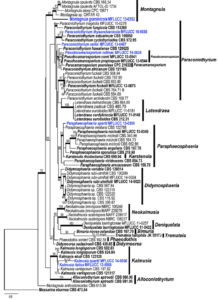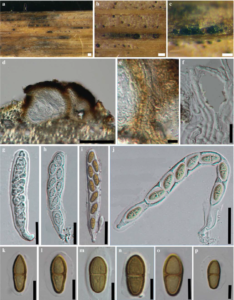Montagnula graminicola Chethana, Thambugala, Camporesi & K.D. Hyde.
Index Fungorum number: IF550763, Facesoffungi number: FoF00379; Fig. 2
Etymology – The specific epithet graminicola was given after the host family Graminae in which the fungus was collected.
Holotypus – MFLU 14–0622
Saprobic on dead stem of grass. Sexual morph Ascomata 37 – 117.22 μm diam. (x̄ = 56.67 μm, n = 20), pseudothecia, mostly solitary, semi-immersed to erumpent, black, globose to subglobose, coriaceous, with a minutely papillate ostiole. Peridium 14.9 μm thick at side walls, up to 16 μm thick near the apex and 9μm thick at the base, consisting of a 3 – 4 layers of cells, outer 3 – 4 layers of thick-walled, dark brown cells of textura angularis and 2 – 3 layers of hyaline to pale brown inner cells. Hamathecium comprising 2 – 3 μm wide, filiform, hyaline, septate, pseudoparaphyses, anastomosing above the asci, embedded in a gelatinous matrix. Asci (45–) 50 – 132 (–137) × (6–) 8 – 13 (–15) μm (x̄ = 81.3 × 10.10 μm, n = 10), 8-spored, bitunicate, fissitunicate, cylindrical to clavate, long pedicellate and apically rounded with a small ocular chamber distinct at immature asci. Ascospores (7.8–) 9.8 – 13 (–15) × (2.8–) 3.8 – 5.5 (–6.5) μm (x̄ = 11.3 × 4.9 μm, n = 25), partially overlapping, biseriate, ellipsoidal, tapering towards the ends, brown, two-celled, septate median, slightly constricted at the septum, wall verruculose, surrounded by a mucilaginous sheath. Asexual morph Undetermined.
Culture characters – Ascospores germinated on water agar within 48 h with 3 – 4 μm diam. germ tubes. Colonies slow growing on PDA, attaining 6 mm diam. after 14 days at 28 °C, entire edged, white to pale white, dense, cottony myceliumon the surface and reverse pale white colourmycelium.
Material examined – ITALY, Province of Forlì-Cesena [FC], Montebello, Modigliana, on dead stem of grass (Graminae), 27 May 2013, E. Camporesi (MFLU 14–0622, holotype); extype living cultures, MFLUCC 13–0352. GenBank ITS: KM658314; LSU: KM658315; SSU: KM658316.
Notes – Montagnula was established by Berlese (1896), with M. infernalis and M. gigantea based on the presence of hyphal stromatic tissue over the ascomata and long pedicellate asci. Montagnula infernalis was selected as the lectotype species and the genus was characterized by immersed to erumpent, globose to subglobose ascomata, bitunicate, cylindro-clavate to clavate, pedicellate asci and reddish brown to dark yellowish-brown, muriform or phragmosporous ascospores (Ariyawansa et al. 2014b). Leuchtmann (1984) and Aptroot (1995) included some phragmosporous and didymosporous species, making it heterogenous (Hyde et al. 2013; Ariyawansa et al. 2014). Recent phylogenetic analyses have shown the robust clustering of M. opulenta with Bimuria, Didymocrea, Letendrea, Paraphaeosphaeria, Didymosphaeria, Pseudocamarosporium, Paracamarosporium, Paraconiothyrium, Tremateia, Deniquelata, Neokalmusia, Phaeodothis, Alloconiothyrium and Kalmusia forming the family clade (Zhang et al. 2009a; Hyde et al. 2013; Ariyawansa et al. 2014b; Wijayawardene et al. 2014). Ariyawansa et al. (2014) synonymized Montagnulaceae under the older family name Didymosphaeriaceae.
In the current study, a new species, Montagnula graminicola is introduced in the genus Montagnula based on the morphological and phylogenetic evidence. Our new species Montagnula graminicola is distinct from M. infernalis in having smaller ascomata, and smaller, ellipsoidal, one-celled ascospores with a sheath. Montagnula graminicola resembles M. opulenta, but differs in having smaller ascomata, and spores with verruculose wall. The phylogenetic analysis provides strong evidence that M. graminicola belongs in the genus Montagnula (Fig. 1), where it forms a sister clade to Montagnula opulenta (CBS 168.34, AFTOL-ID 1734) and Montagnula aloes (CPC 19671) with high bootstrap support; thus a new species is proposed.

Fig. 1 Phylogram generated from Maximum likelihood analysis based on combined SSU, LSU, ß- tubulin and ITS sequence data of Didymosphaeriaceae. Maximum likelihood bootstrap support values greater than 50 % are indicated above and below the nodes, and branches with Bayesian posterior probabilities greater than 0.95 are given in bold. The ex-types (reference strains) are in bold; the new isolates are in blue. The tree is rooted with Massarina eburnea CBS 473.64.

Fig. 2 Montagnula graminicola (holotype) a–c Ascomata submersed in the host tissue d Section of the ascoma e Section of the peridium cells f Pseudoparaphyses g Immature asci h–i Mature asci j Fissitunicate nature of the ascus k–p Brown ascospores with clear sheath. Scale bars: a = 200 μm, b, c, d = 100 μm, e = 5 μm, f =1 5 μm, g – j = 20 μm, k – p = 5 μm.
